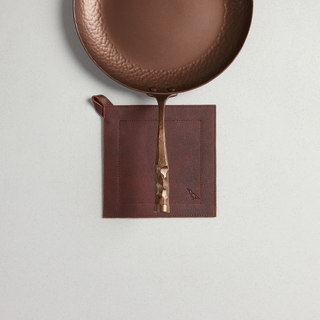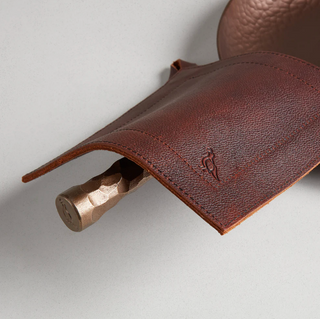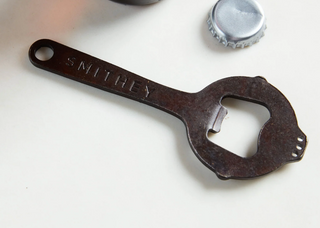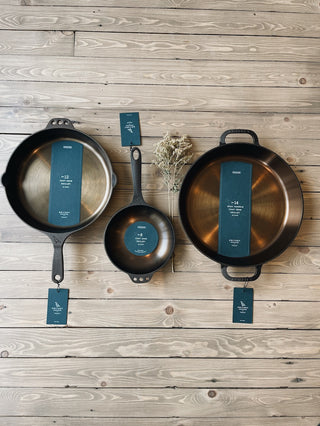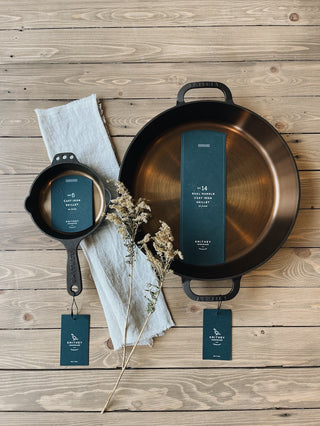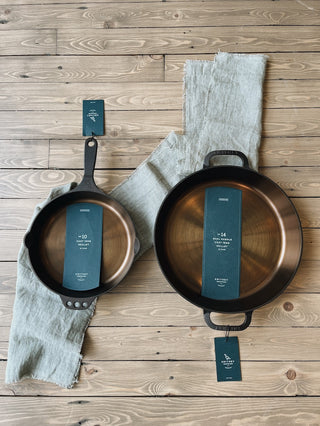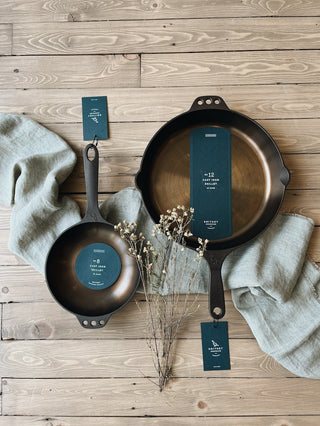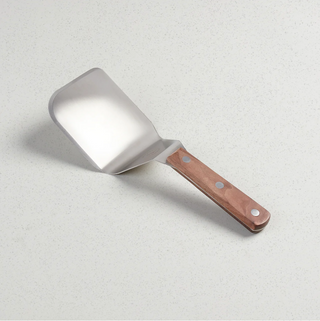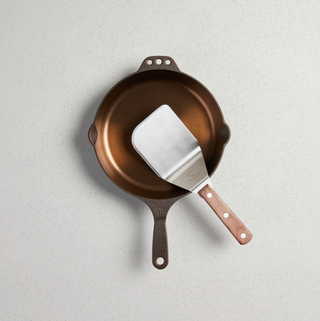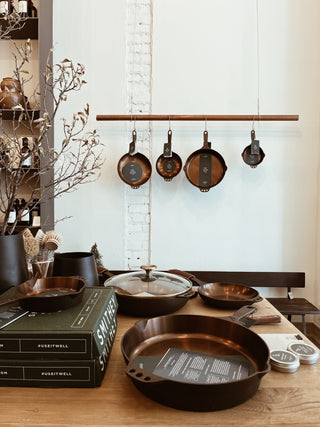
Smithey Ironware
Frequently Asked Questions
CARE
THE BASICS:
- Use it frequently. The oil from your food keeps it healthy.
- Clean with warm water (a few drops of dish soap won't hurt).
- Dry and wipe entire piece with a touch of cooking oil.
HOW DO I CLEAN AND MAINTAIN MY SMITHEY?
We recommend a light wash with warm water to clean your Smithey. If food remnants are stubborn, a soft scrape with a metal spatula, or a touch of dish soap and a nylon scouring pad will work. Avoid heavy-pressure scrubbing. It is important to thoroughly dry your Smithey after each use. Then apply a light layer of vegetable oil and store on your range. We like to place over a burner for a few minutes to ensure it is dry. Don’t put your Smithey in the dishwasher or soak in water.
COOKING ADVICE
Heat slowly. Cast Iron absorbs heat slowly, but retains and emits heat with more effect. This means if you are searing a protein, you will need to give your skillet about 4-5 minutes to reach an appropriate searing temperature. Once your Smithey reaches temperature, it packs a punch.
DURABILITY OF MY SMITHEY
One of the great myths of cast iron is that you need to treat it with extreme care. While we appreciate caring for any cooking tool, cast iron is an extraordinarily durable material. There is very little that you can do that isn’t restorable. If iron has any enemy, it is moisture, so keep it dry and oiled. If you have any questions, shoot us an email at hello@farmersdaughterhomestead.com and we’ll connect with Smithey support.
CAN MY SMITHEY RUST?
If you thoroughly dry and oil your Smithey, rust won’t be a problem. If rust develops, don’t worry - it’s a quick fix. Remove rust by rubbing with scouring pad or paper towel. Now wipe off with water, dry, and apply light layer of oil. Bake in oven at 425 degrees for an hour.
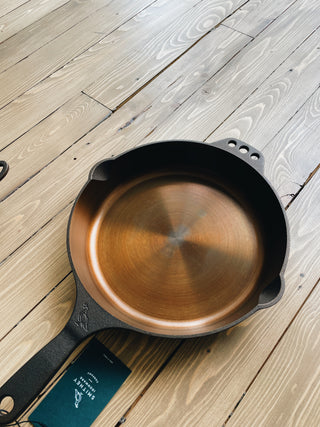
SEASONING
STOVETOP METHOD:
1. Apply a light sheen of vegetable oil to your Smithey’s surface with a paper towel.
2. Bring to scorching temperature until the oil begins to smoke (turn on fan).
3. Rub light sheen of oil onto smoking pan with paper towel.
4. Skillet will turn dark colour. Turn the heat off and allow to cool down.
QUICK TIPS
- Light and even layers build better seasoning.
- A mature coat of seasoning comes from frequent use over time
FIRST DISH
Ground beef & caramelized onions is our favorite dish for building seasoning. The oils from the protein mix with the sugars from the onions to form a nice seasoned base for good things to come.
WHAT IS SEASONING?
Seasoning is a thin layer of oil, that when heated to an appropriate temperature, cures over the surface of your cast iron cookware. Like a layer of paint over your house, seasoning protects cast iron from exposure to air & moisture. In addition to protecting the surface, seasoning helps to establish and enhance a non-stick surface.
IS MY SMITHEY PRE-SEASONED?
Yes. Your Smithey is pre-seasoned with several thin layers of pure grape seed oil after it is finished in our shop. This layer of seasoning protects the skillet before it arrives in your kitchen.
WHAT OIL DO YOU USE TO SEASON YOUR SKILLETS?
We use a pure grape seed oil to season our skillets. However, any off-the-shelf vegetable oil or shortening will do just fine as a seasoning oil. In our home kitchens, we grab whatever oil is handy.
CAN I SEASON IN THE OVEN?
Yes - simply apply a light sheen of oil to the entire skillet and bake in your oven for 1 hour at 450 degrees. We do however, find that the stovetop method we feature above is quicker and more effective.
SEASONING COMING OFF?
Acidic dishes and bacon have a tendency to strip seasoning on a pan without a mature coat of seasoning. No need to be alarmed if some seasoning strips off. Follow the steps for the stovetop seasoning method (see above) and your Smithey will be back in shape in 10 minutes.
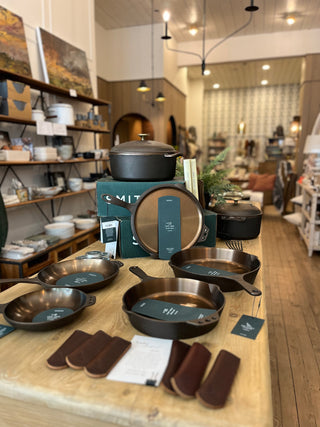
IS MY SMITHEY NON STICK?
Polished cast iron features a smooth surface that becomes naturally non-stick with use. We buff, grind, and polish your Smithey in our workshop to create a simple, beautiful, satin-like surface. That said, we recommend using oil to get the most out of a Smithey. Its non-stick surface will improve as you cook with it and/or add additional seasoning layers.
CAN I COOK ACIDIC FOODS IN A SMITHEY?
Yes! We do recommend building a more mature seasoning layer first before cooking any acidic dishes.
What’s the difference between Cast Iron and Carbon Steel?
We’re often asked to explain the difference between cast iron and carbon steel skillets. Both retain heat exceptionally well and go from stovetop to oven to table. Both are pre-seasoned and ready for cooking. Carbon steel is a bit lighter and heats up a little faster – our cast iron skillets are a bit deeper and are ideally suited for pan-frying and baking. Ultimately, both skillets are great and versatile pieces!
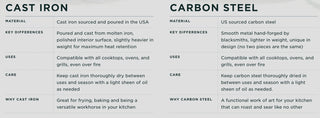
Looking for more information or support?
Contact us at hello@farmersdaughterhomestead.com or (306) 971 1224 and we can help answer any questions you might have!



